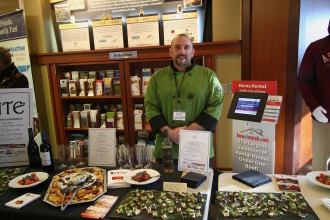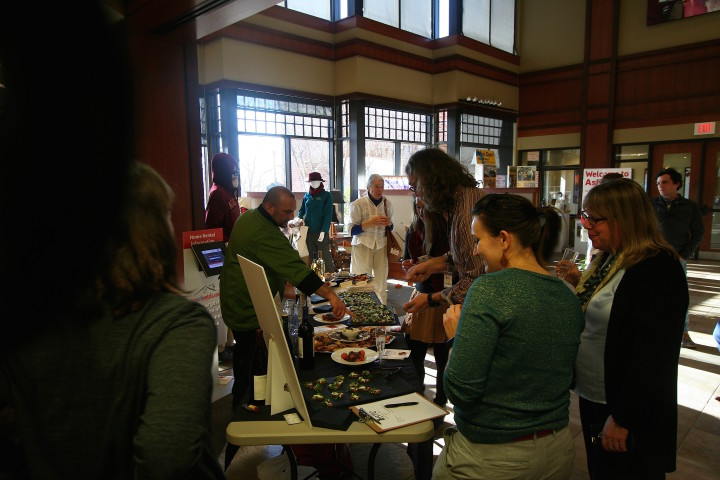The Asheville Truffle Experience happened downtown last weekend for the second time in as many years with guest speaker appearances from regional experts and master chefs sharing their knowledge on the fabled Tuber melanosporum.
A continuation of a smattering of past truffle-related events in the Asheville area, this year’s festival was organized by Susi Gott Séguret. Séguret says she aimed for this year’s festival to pay greater homage to local chefs while, at the same time, reaching out to an international audience. “It can be challenging to tackle such a grandiose task,” Séguret says. “But all the ingredients for an event of this kind are plentiful in Asheville: chefs, food fanatics, farms, product.
“It only takes time and a huge dose of imagination and faith,” she continues. “I believe we have the potential to see this experience grow quickly from local to national to international as long as people are aware of how incredibly lucky they are to have this extraordinary ingredient close to their fingertips.”
ATE holds a special place as one of the only — if not the only — trufflecentric event on the entire East Coast. “I’m sure folks in New York will catch on eventually,” Séguret jokes, noting that historically, North Carolina was the first place in the United States to cultivate Perigord truffles, though she admits truffle growers in Oregon may dispute that claim.
Festivities kicked off on Friday, Feb. 19, with a free reception in the Asheville Chamber of Commerce Visitors Center, where Strada and Social Lounge chef Anthony Cerrato offered several truffle-infused appetizers, including crostini topped with truffled goat cheese, toasted Marcona almonds and microgreens from Moody’s Farm in North Asheville.

“Truffles typically go well with cheeses,” says Cerrato. “Anything buttery or nutty is a good way to accent their flavor.”
Later Friday evening, the celebration continued with a special dinner menu by chef William Dissen of The Market Place Restaurant, which included a dish of venison tartare, popped sorghum, foraged sumac aioli and shaved truffle. Dissen also served cold-smoked Sunburst Farms trout with Carolina rice cake and shaved truffles, in addition to other sides.
Saturday, the Experience continued with a presentation by Dr. Tom Michaels, a local truffle expert who’s been cultivating the underground fungi in his Tennessee orchard since 2000. Also presenting were Lois Martin, instructor at the Truffle Dog Company, and Jane Morgan Smith, retired executive director of the North American Truffle Growers’ Association, at Isa’s Bistro, beginning at 10 a.m.
That afternoon, Cerrato held a live culinary demonstration at the Weinhaus where he prepared duck breast infused with lavender, fresh sage and truffles, and spinach pasta with cippolini cream, truffles and shaved pecorino cheese.
To cap off the weekend, Isa’s Bistro hosted a four-course Truffle Extravaganza dinner with chef Duane Fernandes that featured dishes such as a truffled potato leek soup with garlic chips and parsley oil, and a pan-seared New York strip with white bean cassoulet, pickled pearl onions and truffle vinaigrette.
Truffle cultivation in Western North Carolina is likely to come even closer to becoming a reality next year, says Séguret, with plans for an orchard plantation at her alma mater, Warren Wilson College, on the agenda for this coming autumn.
Through the Asheville Truffle Experience, Séguret hopes to shed light on this legendary delicacy, and why it is worth the seemingly exorbitant prices one must be prepared to pay to add a grating to a dish. “Truffles are a rich man’s condiment that turns a poor man’s meal into a feast,” she says. “They go well with such basic staples as pasta, rice and potatoes, with the addition of butter and cream, of course. It’s thrilling that this legacy has travelled from European aristocracy to the unlikely tobacco fields of Appalachia.”
For more information on the Asheville Truffle Experience or on sponsoring or attending the event in 2017, visit ashevilletruffle.com.




Thank, Max, for this delightful tribute. One correction: Lois Martin is the instructor at the Truffle Dog Company, and Jane Morgan Smith is the retired executive director of the North American Truffle Growers’ Association, rather than the other way around. Also, truffle cultivation in North Carolina has been a reality since Franklin Garland produced his first truffle in 1992, although it is taking a slight set-back at present while adventurous farmers figure out how to vanquish the Eastern Filbert Blight which has ravaged much of their initial plantations. Meanwhile, Dr. Tom Michaels in East Tennessee manages to maintain a steady if modest stream, and NATGA (The North American Truffle Growers Association), as well as the WNC Research Station in Waynesville, is making strides in bringing growers together to learn from their collective trials and errors. It is the beginning of an exciting era!
Thanks for clarifying Susi! I’ve updated the content to reflect Ms. Smith & Ms. Martin’s proper position. Sorry about that!
I hope you have the Truffle festival the year, do you have a date get, if you do, what is it, love to attend.